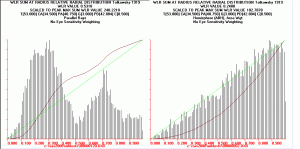- Joined
- Aug 29, 2003
- Messages
- 15,808


----------------
On 9/17/2004 10:10:40 PM Garry H (Cut Nut) wrote:
...An Israeli firm cut them to my specs ----------------

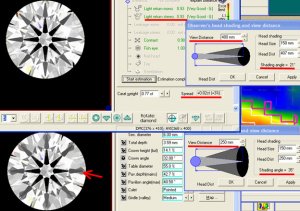



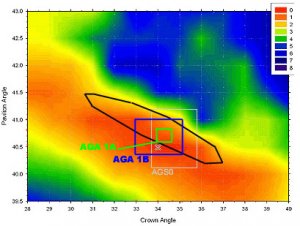
----------------
On 9/16/2004 10:37:37 PM valeria101 wrote:
Is the AGS going to state the new rule with a range of crown and pavilion angles as before? Or some crown&pav relation?
I am not sure if the drawing shows the problem well: but... using a range for each of the two angles (the old way) one can obtain a square on the chart.
If the new ideal range is as Garry drawn it, than it is not feasible to define it in the old way - otherwise the resulting rectangular area will go way outside the desirable range (shown left) or… you need allot of little squares (right) each for a certain narrow range of crown and pavilion angles (right). The first version leaves undesirable areas inside the advised range, and the second version yields a hard to justify grade with debatable no-go areas. IMO.
----------------


----------------
On 9/19/2004 3:49:19 PM Garry H (Cut Nut) wrote:
Great points Marty.
I agree with pretty well all of them.
(That is probably a first - GH and MH agreeing publicly)
Sergey's OctoNus solution will address all your issues (especialy size differences), and the most important one that you left out.
Fire is dependant on lighting type. and so far everyone has modeled fire the wrong way. They have used rays of parallel light. Direct light from the sun is the only valid case.
Light from globes, strips, windows and walls is very different and has a completly different effect - and sergey has found a new way to model itAnd account for pupil size variations in different intensity / brightness.
There is aother thread you should read Marty ----------------
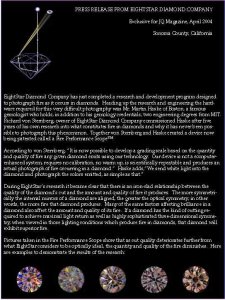
----------------
On 9/19/2004 11:26:47 PM Richard Sherwood wrote:
Hey Marty, is that Fire Performance Scope on the market?
----------------
----------------
On 9/19/2004 11:36:10 PM Rank Amateur wrote:
What is the nature of the light heading into the stone which is measured by this instrument? The diagram seems to indicate parallel rays with the viewer at an angle, yet the photos would be from a top-down viewing position. Or are the photos some sort of composite?
Seems like the original 'FireScope' was mis-named. ----------------
----------------
On 9/19/2004 11:36:10 PM Rank Amateur wrote:
Seems like the original 'FireScope' was mis-named. ----------------
----------------
On 9/20/2004 12:32:39 AM Garry H (Cut Nut) wrote:
Does your method outlined in that article 'quantify' fire Marty?
Would you call a system like the Firescop(r) or ideal-Scope a grading scale Marty?
We believe the collomation of light is a no-no. Hope you are using beams or cones and not rays----------------
----------------
On 9/20/2004 9:37:37 AM adamasgem wrote:
----------------
On 9/20/2004 12:32:39 AM Garry H (Cut Nut) wrote:
If you are playing theoretical games regarding using collimation of light rays, then I probably agree with your statement, as collimated sources really don't exist in nature here on earth, but quasi collimated sources in use, or modeled by, let us say, GIA, are fine for a thoretical study, but are inappropriate for use as a metric in grading diamonds, in my opinion.
----------------
Hi Marty,
Did you read below text?
Do you agree with statements or not?
http://www.cutstudy.com/cut/english/grading1/6.htm
Therefore:
In the GIA model, the probability of observing a green ray is the same as that for any other color. In real diamonds, green rays are observed much more rarely than blue and yellow rays;
GIA metric for dispersed color light return DCLR is almost independent of dispersion. For example, if we consider a material, the dispersion of which is two times weaker than that of diamond, the DCLR will be almost the same as that for diamond! Moreover, if we suppose that there is absolutely no dispersion in the material of the considered stone, the DCLR not only fails to become zero, but even remains close to the value calculated by GIA (just dispersion, not refractive index). Let us consider green color, which is located in the center of visual color range and red and blue colors lie on opposite sides of the green color, at equal distances on visual spectrum. The deviation of blue and red spots from green spot on registration sphere depends on the dispersion of the material. In any case, these deviations are small enough and almost equal one another. Note
When calculating DCLR, the GIA team performs summation. As a result, the red and blue rays compensate each other, and their overall mean DCLR is almost equal to that of the central green ray. Then let us change (decrease) dispersion value of material fixing refractive index for green color. The location of all such green spots on the sphere used by the GIA group for registration will not change, and blue and red spots will be closer to green. When calculating DCLR blue and red rays again compensate each other and we will get the same DCLR value as before!
This statement can be illustrated by the following formula:
Here for each arbitrary light beam:
a - direction of green ray
2d - angle between red and violet rays.
It is clear from the common sense that if dispersion equal zero fire will not appear. Thus, the following questions arise: What is the merit of the GIA's approach from the viewpoint of modeling the fire and what does the DCLR metric actually describe?
----------------
On 9/21/2004 2:15:43 AM Serg wrote:
----------------
On 9/20/2004 9:37:37 AM adamasgem wrote:
----------------
On 9/20/2004 12:32:39 AM Garry H (Cut Nut) wrote:
If you are playing theoretical games regarding using collimation of light rays, then I probably agree with your statement, as collimated sources really don't exist in nature here on earth, but quasi collimated sources in use, or modeled by, let us say, GIA, are fine for a thoretical study, but are inappropriate for use as a metric in grading diamonds, in my opinion.
----------------
Hi Marty,
Did you read below text?
Do you agree with statements or not?
http://www.cutstudy.com/cut/english/grading1/6.htm
Therefore:
In the GIA model, the probability of observing a green ray is the same as that for any other color.
Sergey, I think that might have to do with the probability of incident rays
In real diamonds, green rays are observed much more rarely than blue and yellow rays;
Haven't proved that one to myself
GIA metric for dispersed color light return DCLR is almost independent of dispersion.
Haven't modeled it yet so I can't say
For example, if we consider a material, the dispersion of which is two times weaker than that of diamond, the DCLR will be almost the same as that for diamond!
Moreover, if we suppose that there is absolutely no dispersion in the material of the considered stone, the DCLR not only fails to become zero, but even remains close to the value calculated by GIA (just dispersion, not refractive index).
Interseting, if that is the case, then they have a serious theoretical problem with their metric
Let us consider green color, which is located in the center of visual color range and red and blue colors lie on opposite sides of the green color, at equal distances on visual spectrum. The deviation of blue and red spots from green spot on registration sphere depends on the dispersion of the material. In any case, these deviations are small enough and almost equal one another. Note
When calculating DCLR, the GIA team performs summation. As a result, the red and blue rays compensate each other, and their overall mean DCLR is almost equal to that of the central green ray. Then let us change (decrease) dispersion value of material fixing refractive index for green color. The location of all such green spots on the sphere used by the GIA group for registration will not change, and blue and red spots will be closer to green. When calculating DCLR blue and red rays again compensate each other and we will get the same DCLR value as before!
Seems they shouldn't be averaging the rays but averaging the differences between the red and blue rays or something like that
It is clear from the common sense that if dispersion equal zero fire will not appear.
Seems like a reasonable assumption
Thus, the following questions arise: What is the merit of the GIA's approach from the viewpoint of modeling the fire and what does the DCLR metric actually describe?
Can't answer that question Sergey, I just don't know (yet), haven't studied it
----------------
----------------
On 9/21/2004 12:01:13 PM adamasgem wrote:
----------------
On 9/21/2004 2:15:43 AM Serg wrote:
----------------
On 9/20/2004 9:37:37 AM adamasgem wrote:
----------------
On 9/20/2004 12:32:39 AM Garry H (Cut Nut) wrote:
----------------
Seems they shouldn't be averaging the rays but averaging the differences between the red and blue rays or something like that
----------------
----------------
GIA use Area*Smoothed Intensity*Weighting Factor
see http://www.gia.edu/pdfs/Fall_2001_Cut.pdf
p.10
If Smoothed Intensity is close to real Intensity( Intensity of real spot in real world) , Area*Smoothed Intensity should be like constant
If theoretical Intensity of "Streake" do not depends from angle of dispersion( depends from Frenel law only), the Area*Smoothed Intensity is like Area.(or angle of Dispersion*) It is much better, but It has not good correlation with Fire for real Purple(or Source Light)
addendum:
* For case The "GIA Area " is Total Area of spot from red to blue rays.
For case the "GIA Area " is Area of spot 10 nm only, Area*Frenel Intensity=constant ( and DCLR does not depend from dispersion )
The main question : What is GIA Area and GIA Smoothed Intensity?
In DCLR the Area is integrable by color. It may be to mean GIA Area is not Total Area of spot from red to blue rays
----------------
GIA use Area*Smoothed Intensity*Weighting Factor
see http://www.gia.edu/pdfs/Fall_2001_Cut.pdf
p.10
If Smoothed Intensity is close to real Intensity( Intensity of real spot in real world) , Area*Smoothed Intensity should be like constant
If theoretical Intensity of 'Streake' do not depends from angle of dispersion( depends from Frenel law only), the Area*Smoothed Intensity is like Area.(or angle of Dispersion*) It is much better, but It has not good correlation with Fire for real Purple(or Source Light)
addendum:
* For case The 'GIA Area ' is Total Area of spot from red to blue rays.
For case the 'GIA Area ' is Area of spot 10 nm only, Area*Frenel Intensity=constant ( and DCLR does not depend from dispersion )
The main question : What is GIA Area and GIA Smoothed Intensity?
Sergey.. I looked at what GIA did, and I couldn't make heads or tails of it so I've been concentrating my efforts at modeling the environment which allows me to take the Fire pictures. What I see in a well cut stone with high optical symmetry (like an EightStar) is that facets light up in pure spectral hues, tha whole facet inytersetingly, where as in off cut stones the facets are pastels or earth tones, sort of a color mixing, or they are just black.
I have looked at the WLR distributions for parallel ray inputs and rather than a quasi uniform distribution (for hemispherical lighting) the WLRs for the GIA Fire model (parallel rays) group into clusters of intensity, as a function of the cutting..
See my comparison.. These clusters probably relate to the dispersion patterns GIA sees, (sort of a colored gemprint)
As I say, I'm off on a different track, trying to mathematically explain what I can photograph..
In DCLR the Area is integrable by color. It may be to mean GIA Area is not Total Area of spot from red to blue rays
----------------
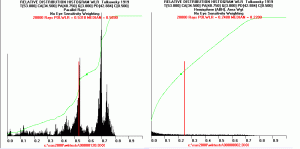
----------------
On 9/22/2004 1:01:06 AM adamasgem wrote:
----------------
I have looked at the WLR distributions for parallel ray inputs and rather than a quasi uniform distribution (for hemispherical lighting) the WLRs for the GIA Fire model (parallel rays) group into clusters of intensity, as a function of the cutting..
See my comparison.. These clusters probably relate to the dispersion patterns GIA sees, (sort of a colored gemprint)
----------------
Marty,
I can not understand How WLR is connecting with GIA Fire.
What output are you calculating?
Of course Fire for Hemisphere light should be close for any cut, because there is few Fire for this type of light
----------------
On 9/22/2004 3:36:08 AM Serg wrote:
----------------
Marty,
I can not understand How WLR is connecting with GIA Fire.
What output are you calculating?
Of course Fire for Hemisphere light should be close for any cut, because there is few Fire for this type of light ----------------
Segey.. What I have plotted is the probability distribution functions for WLR for the two lighting modes, hemispherical (used in the brilliance study) and parallel (used in their Fire article). The red line is the mean value of WLR, which is the number used in yors and GIA contour maps, and the green curve is the cummulative distribution function for WLR. The graphs shown are for the Tolkowsky cut model.
The spikiness of the parrallel model results relate or probably corrrelate to the intensity of the chromatic flare points GIA see (although not directly, because of the cosine square weighting).
Anyways the graphs suggest two things..
1) The distribution function of WLR for the Hemispherical model suggest that we don't have much confidence in the "average" WLR used, i.e. the uncertainty about the mean value of WLR often quoted as a measure of the cuts quality. The quasi uniform distribution functions for WLR create a quandry in that even though you can draw a quasi smooth WLR contour map for a range of, lets say crown and pavilion angles, there isn't a statistically significant difference between any two values, but thats just based on the numerics, mean and uncertainty of the mean. The distribution functions of course, are not characteristic of a classic gaussian normal distribution function nor are they a uniform distribution.
2) When we confine the rays to to parallel inputs, we see the spikiness in the distribution functions, and the spikiness varys quite a bit depending on the cut. There is definately a correlation to the "patterns" of chromatic flares that GIA has shown, although I'm not sure of the mathematics relating DCLR and WLR metrics, although DCLR is a function of intensity as I read it.
I'll go back and see if I saved the radial distribution functions for WLR, where I generated WLR versus radial position from the center of the stone..
----------------
On 9/22/2004 10:39:25 AM Serg wrote:
Marty,
The axis of absciss is latitude or is not?
What is 0 and 1 on axis of absciss?----------------
